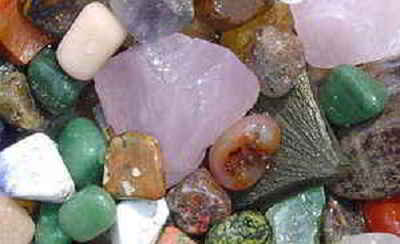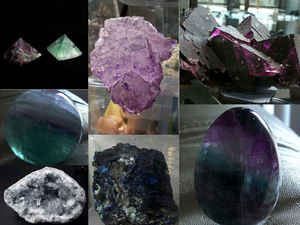
Utah Symbols
Utah State Mineral
Copper

(Cu)
Adopted in 1944.
Utah's State Mineral, copper, was enacted by the Utah State Legislature in 1994 (Utah Code). The discovery of copper dates from prehistoric times. It is said to have been mined for more than 5000 years. It is one of man's most importantmetals. Copper is reddish colored, takes on a bright metallic luster, and is malleable, ductile, and a good conductor of heat and electricity (second onlyto silver in electrical conductivity). The electrical industry is one of the greatest users of copper.
.
Utah State Mineral: Copper

Minerals, in the form of copper ore,
were first discovered in Bingham Canyon in 1848 by two brothers, Sanford and Thomas Bingham, sons of Erastus Bingham, Mormon pioneers of September
1847, who grazed their family and other cattle there. They reported their find to their leader, Brigham Young, who advised against pursuing mining
operations because the survival and establishment of settlements was of paramount importance at that time. The brothers applied themselves to that
purpose as directed and did not stake a claim. In 1850, the Bingham family went to settle what is now Weber County, leaving the canyon still today
known by their name
It was not until 1863 that extraction of ore began and the potential of the canyon's mineral resources began to be widely recognized. At first, mining
was difficult due to the area's rugged terrain, but a railroad reached the canyon in 1873, prompting greatly increased mining activity and accompanying
settlement.
It is versatile and widely used due mainly to its conductive properties (heat and electricity). It is used in electronics, plumbing, transportation, and in alloys (a mixture of two or more metals). Most of the copper mined in Utah comes from Kennecott's Bingham Canyon mine in the Oquirrh Mountains on the west side of the Salt Lake Valley.

That copper comes from the Bingham Canyon Mine, the largest open pit copper mine in the world, located about 28 miles southwest of Salt Lake City, Utah. The Bingham Canyon mine measures 0.5 miles deep and 2.5 miles wide. For perspective, the world's tallest building, the Sears Tower, is l,454 feet tall and would reach only half way up the side of the pit. the mine has produced 12 million tons of copper since open-pit operations began in 1906. This production figure is eight times the total metallic mineral yield from the Comstock Lode, Klondike, and California Gold Rushes combined.
The Bingham Canyon mine is an important contributor to Utah's economy. Kennecott Utah Copper provides about 15% of this country's copper needs. The computer you're sitting in front of right now contains copper wire, it may have come from Kennecott. Every year, Kennecott produces about 258,000 tons of refined copper - along with 389,000 ounces of gold, 3 million ounces of silver, about 18 million pounds of molybdenum, and about 1 million tons of sulfuric acid, a by-product of the smelting process.
PHYSICAL CHARACTERISTICS OF COPPER:
 Copper is a chemical element with the symbol Cu
(from Latin: cuprum) and atomic number 29. It is a ductile metal with very high thermal and electrical conductivity. Pure copper is soft and malleable;
a freshly exposed surface has a reddish-orange color. It is used as a conductor of heat and electricity, a building material, and a constituent of
various metal alloys.
Copper is a chemical element with the symbol Cu
(from Latin: cuprum) and atomic number 29. It is a ductile metal with very high thermal and electrical conductivity. Pure copper is soft and malleable;
a freshly exposed surface has a reddish-orange color. It is used as a conductor of heat and electricity, a building material, and a constituent of
various metal alloys.
The metal and its alloys have been used for thousands of years. In the Roman era, copper was principally mined on Cyprus, hence the origin of the name
of the metal as сyprium (metal of Cyprus), later shortened to сuprum. Its compounds are commonly encountered as copper(II) salts, which
often impart blue or green colors to minerals such as azurite and turquoise and have been widely used historically as pigments. Architectural structures
built with copper corrode to give green verdigris (or patina). Decorative art prominently features copper, both by itself and as part of pigments.
Copper is essential to all living organisms as a trace dietary mineral because it is a key constituent of the respiratory enzyme complex cytochrome
c oxidase. In molluscs and crustacea copper is a constituent of the blood pigment hemocyanin, which is replaced by the iron-complexed hemoglobin in
fish and other vertebrates. The main areas where copper is found in humans are liver, muscle and bone. Copper compounds are used as bacteriostatic
substances, fungicides, and wood preservatives.
- Color is copper colored with weathered specimens tarnished green.
- Luster is metallic.
- Transparency is opaque.
- Crystal System is isometric; 4/m bar 3 2/m
- Crystal Habits include massive, wires and arborescent or branching forms as the most common, whole individual crystals are extremely rare but when present are usually cubes and octahedrons. Occasionally, massive forms will show some recognizable crystal faces on outer surfaces.
- Cleavage is absent.
- Fracture is jagged.
- Streak is reddish copper color.
- Hardness is 2.5-3
- Specific Gravity is 8.9+ (above average for metallic)
Folklore of Copper 
Copper meaning
Any stone set in copper or used with copper with have an enhanced energy field. Copper even enhances the energy of silver and gold. There are some
stones that are very powerful when used with copper. These stones are:
- Azurite
- Chrysocolla
- Malachite
- Turquoise
Copper is a healing metal
Copper has long been used as a healing metal, especially for arthritis and rheumatism. Copper has been used with blood and metabolism disorders. Copper
acts as a conductor when worn on the body. Copper will help the healing effect of any stone when both touch the body.
Utah Law
The law designating copper as the official Utah state mineral is found in the Utah Statutes, Title 63, Chapter 13, Section 63-13-5.5 (19).
TITLE 63. State Affairs in General.
CHAPTER 13. Miscellaneous Provisions.
SECTION 63-13-5.5. State Symbols.
63-13-5.5. State symbols.
(1) Utah's state animal is the elk.
(2) Utah's state bird is the sea gull.
(3) Utah's state centennial astronomical symbol is the Beehive Cluster located in the constellation of Cancer the Crab.
(4) Utah's state centennial star is Dubhe, one of the seven bright stars composing the Big Dipper in the constellation Ursa Major.
(5) Utah's state centennial tartan, which honors the first Scots known to have been in Utah and those Utahns of Scottish heritage, shall have a pattern
or repeating-half-sett of white-2, blue-6, red-6, blue-4, red-6, green-18, red-6, and white-4 to represent the tartan worn anciently by the Logan and
Skene clans, with the addition of a white stripe.
(6) Utah's state cooking pot is the dutch oven.
(7) Utah's state emblem is the beehive.
(8) Utah's state fish is the Bonneville cutthroat trout.
(9) Utah's state flower is the sego lily.
(10) Utah's state folk dance is the square dance, the folk dance that is called, cued, or prompted to the dancers and includes squares, rounds, clogging,
contra, line, and heritage dances.
(11) Utah's state fossil is the Allosaurus.
(12) Utah's state fruit is the cherry.
(13) Utah's state vegetable is the Spanish sweet onion.
(14) Utah's historic state vegetable is the sugar beet.
(15) Utah's state gem is topaz, as is prominently found in the Thomas Mountain Range in Juab County, Utah.
(16) Utah's state grass is Indian rice grass.
(17) Utah's state hymn is "Utah We Love Thee" by Evan Stephens.
(18) Utah's state insect is the honeybee.
(19) Utah's state mineral is copper.
(20) Utah's state motto is "Industry."
(21) Utah's state railroad museum is Ogden Union Station.
(22) Utah's state rock is coal.
(23) Utah's state song is "Utah This is the Place" by Sam and Gary Francis.
(24) Utah's state tree is the blue spruce.
Minerals, & Gems

Gemstone, Minerals, Rocks






